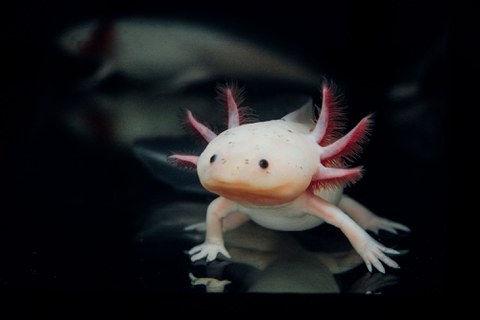27.10.2023
Seneszente Zellen entscheidend für die Regeneration in Axolotl

Axolotl – der mexikanische Salamander mit einzigartigen regenerativen Fähigkeiten hilft Wissenschaftlern, die molekularen Mechanismen der Regeneration aufzudecken.
Seneszente Zellen wurden mit einer Vielzahl von Prozessen in Verbindung gebracht, die normalerweise mit Verschlechterung und Alterung verknüpft sind. Aktuelle Studien deuten jedoch darauf hin, dass die kurzfristige Anwesenheit von seneszenten Zellen tatsächlich von Vorteil sein kann. Eine neue umfassende Studie der Yun-Gruppe zeigt, dass die zelluläre Seneszenz eine entscheidende Rolle bei der Regeneration von Axolotl-Gliedmaßen spielt. Seneszente Zellen in der regenerierenden Struktur nutzen den Wnt-Signalweg, um auf umgebende Zellen zu wirken und eine Mikroumgebung zu schaffen, die die Regeneration und das Wachstum begünstigt. Die Ergebnisse wurden im Journal „Developmental Cell" veröffentlicht.
Seneszente Zellen, oft als „Zombie-Zellen" bezeichnet, teilen sich nicht mehr, sterben aber auch nicht ab. Ihr Anstieg gilt als eines der Kennzeichen des Alterns. Allerdings deuten aktuelle Studien darauf hin, dass sie auch eine Rolle in positiven Prozessen wie der Wundheilung und der Unterdrückung von Tumoren spielen können.
„Unser Verständnis der Rolle seneszenter Zellen in regenerativen Prozessen ist sehr begrenzt. Da die meisten aktuellen Erkenntnisse auf In-vitro-Studien basieren, war es für uns klar, dass wir, um neue Erkenntnisse zu gewinnen, eine Möglichkeit finden müssen, seneszente Zellen In-vivo zu untersuchen, d.h. sie während des Regenerationsprozesses im Tier zu analysieren", sagt Dr. Maximina Yun, Forschungsgruppenleiterin am Zentrum für Regenerative Therapien Dresden (CRTD) und am Exzellenzcluster Physik des Lebens an der TU Dresden sowie am Max-Planck-Institut für molekulare Zellbiologie und Genetik (MPI-CBG) in Dresden.
Die Regeneration beim Axolotl studieren
Um den Regenerationsprozess zu studieren, wandte sich die Yun-Gruppe Axolotln zu. Diese mexikanischen Salamander gehören zu einer Handvoll Arten, die komplexe Körperteile wie Gliedmaßen, Rückenmark und Teile ihrer Augen, Herzen und Gehirne regenerieren können. Bei Verletzungen verschließen Axolotl ihre Wunde und bilden einen Blastema - eine besondere Zellmasse, die Vorläuferzellen enthält. Im Laufe der Zeit differenzieren sich diese Zellen und rekonstruieren das Repertoire an Geweben, das für ein funktionelles Körperteil benötigt wird.
„Nach einer Verletzung sind seneszente Zellen kurzfristig im Blastema vorhanden. Wir fanden einen cleveren Weg, um gezielt nur diese Zellen zu erfassen und sie auszuschalten. Auf diese Weise konnten wir beobachten, was mit dem Regenerationsprozess geschieht, wenn die seneszenten Zellen praktisch verschwunden sind", erklärt Dr. Yun.
Schadensbegrenzung und Reparaturförderung
Das Team fand heraus, dass ohne die seneszenten Zellen weniger Zellteilungen stattfanden, was die Regeneration effektiv aussetzte. Es war, als ob die seneszenten Zellen im Blastema Signale an ihre benachbarten Zellen sandten, damit diese sich teilen. „In diesem Zusammenhang ist ein Schlüsselmerkmal seneszenter Zellen tatsächlich ihre Fähigkeit, ihre unmittelbare Umgebung zu modulieren", fügt Dr. Yun hinzu.
Basierend auf den Ergebnissen konnte das Team zeigen, dass diese Zellen Moleküle absondern, die zum sogenannten Wnt-Signalweg gehören, um benachbarte Zellen zu signalisieren. Ihre anschließenden Experimente zeigten, dass die Signalgebung zweifach funktioniert. Erstens verhindert sie, dass die Vorläuferzellen seneszent werden. Zweitens fördert sie deren Vermehrung, und somit das Nachwachsen des fehlenden Gewebes.
Eine Mischung aus hochmodernen Ansätzen
In Zusammenarbeit mit dem DRESDEN-concept Genome Center und den Labors der CRTD-Alumni Prof. Volker Busskamp und Dr. Sumeet Pal Singh verwendete das Team die RNA Einzelzelltranskriptomik, um verschiedene Merkmale der seneszenten Zellen im Blastema zu analysieren. Dadurch konnten sie den Wnt-Signalweg identifizieren, den seneszente Zellen nutzen, um ihre Umgebung zu beeinflussen. Die RNA-Analyse zeigte auch den Ursprung der seneszenten Zellen im Blastema.
„Wir fanden heraus, dass die seneszenten Zellen hauptsächlich aus dem Bindegewebe und den Makrophagen stammen, speziellen Immunzellen, die im Gewebe vorhanden sind. Wir konnten auch zeigen, dass ihre Seneszenz wahrscheinlich durch Störungen der ribosomalen Biogenese verursacht wird. Ihre Fabriken für die Proteinsynthese sind dereguliert, und dies kann zu einem Stillstand des Zellzyklus führen, was wiederum Seneszenz auslöst", erklärt Dr. Yun.
Um die seneszenten Zellen im Gewebe direkt zu beeinflussen und auszuschalten, arbeitete die Gruppe mit Prof. Ramón Martínez-Mañez zusammen, um speziell beschichtete Nanopartikel zu entwickeln, die durch das Gewebe reisen und ausschließlich an seneszenten Zellen binden können.
„Regeneration ist ein komplexes Phänomen. Je mehr wir darüber wissen, desto mehr erkennen wir, wie stark es auf das Zusammenspiel verschiedener Gewebe angewiesen ist. Es ist daher entscheidend, den Regenerationsprozess als Ganzes und in seinem natürlichen Kontext eines Tieres zu betrachten", erklärt Dr. Yun. "Es erfordert auch einen interdisziplinären Ansatz."
Originale Veröffentlichung
Qinghao Yu, Hannah E. Walters, Giovanni Pasquini, Sumeet Pal Singh, Martina Lachnit, Catarina R. Oliveira, Daniel León-Periñán, Andreas Petzold, Preethi Kesavan, Cristina Subiran Adrados, Ines Garteizgogeascoa, Dunja Knapp, Anne Wagner, Andrea Bernardos, María Alfonso, Gayathri Nadar, Alwin M. Graf, Konstantin E. Troyanovskiy, Andreas Dahl, Volker Busskamp, Ramón Martínez-Máñez, Maximina H. Yun: Cellular senescence promotes progenitor cell expansion during axolotl limb regeneration. Developmental Cell (October 2023)
Link: https://doi.org/10.1016/j.devcel.2023.09.009
Wissenschaftlicher Ansprechpartner:
Dr. Maximina H. Yun
E-mail:
